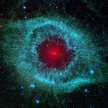Our Journey on a Massive Rock
We all live on the surface of a rock that orbits a star which also orbits a black hole at the centre of our galaxy.
British spelling
Most of us give little thought to why we are here and where we are going. To us, it seems like our planet is stationary in space, but that is far from the truth.
If you were standing on the equator, the widest part of the Earth, you'd be speeding along at 1,600 kilometres per hour. That speed is a result of the Earth spinning on its axis once every 24 hours.
While travelling around the sun on its yearly trip, the Earth is racing along at 107,000 kilometres per hour.
The Earth and the other 7 planets follow the Sun on its journey around the centre of our galaxy, the Milky Way. That orbit is called a galactic year, and it takes an estimated 230 million years to complete.
As we travel around the centre of our galaxy, our planet is speeding along at roughly 292,000 km/h.
To top it off, our galaxy with us on board is travelling through space at over 2 million km/h, and we don't even notice it.
The Milky Way, our spiral galaxy, is part of the local group of 50 or more galaxies, and on a bigger scale, the local group is part of the Virgo supercluster of galaxies.
The Milky Way is roughly 100,000 light-years across, which is a vast distance; one light-year is equivalent to 9.46 trillion kilometres.
One trillion is a 1 followed by 12 zeros.
It is difficult for astronomers to give an accurate assessment of how many stars there are in the Milky Way; a lower estimate would be 100 billion stars, and higher estimates can be up to 400 billion.
Many of the star systems scattered throughout our galaxy will be similar to our solar system, which consists of all the planets, dwarf planets, moons, asteroids, and every other celestial body that orbits the Sun.

Our solar system is situated approximately 26,000 light-years from the Milky Way's centre and positioned halfway along the Orion Arm, which is 10,000 light-years in length.
The total mass contained in the Milky Way galaxy is estimated to be 1.5 trillion times the mass of the Sun. If you could mix up all the mass and the space in the Milky Way so that it was distributed equally, then each cubic light-year of space would contain around 40% of the Sun's mass.
It may seem like a large mass, but a one-light-year cube is a huge volume of space.
It is also difficult for astronomers to figure out what the Milky Way looks like. The shape of our galaxy has to be worked out from within. We can see other distant galaxies with all their complex shapes and sizes, but there has never been anyone or anything from Earth outside our galaxy to take a picture.
And considering the vast distances involved, I think it is safe to say that there never will be.
Lurking at the centre of our galaxy is a black hole called Sagittarius A*. Its diameter is 44 million kilometres and it has an estimated mass of 4 million times that of the Sun.
But having said all that, the Earth, Sun, solar system, and even our galaxy are minuscule in comparison to that gargantuan area we call the universe.
The end.
<> <> <>
It is estimated that primitive life started almost four billion years ago, evolution is thought to be the reason for all the complex life we see on earth today.
<> <> <>
You may find my easy-to-understand stories about the universe and life interesting and educational.
If you subscribe to me for free, you will see my latest stories. Regards.
About the Creator
Unravelling the Universe
We can only imagine what our early ancestors thought as they gazed up at the night sky—were they curious about what the heavens had to hide?







Comments (1)
You're doing amazing work